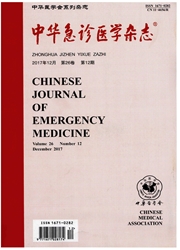

 中文摘要:
中文摘要:
目的 探讨短暂脑缺血对大鼠海马CA1区神经元内蛋白酶体的影响.方法 采用20min全脑缺血大鼠模型.36只大鼠按照再灌注时间分为假手术组(只将颈总动脉剥离出来但不夹闭),24 h恢复组,72 h恢复组.采用HE染色光镜观察脑缺血后神经元死亡;以SUG-LLVY-AMC为底物测定蛋白酶体活性;应用免疫组织化学激光扫描共聚焦显微镜观察及蛋白印迹分析短暂脑缺血后蛋白酶体在细胞内的分布及数量变化.结果 HE染色显示,再灌注72 h后海马CA1区神经元全部死亡;蛋白酶体活性分析显示再灌注24 h后蛋白酶体活性呈现持续性下降,直至神经元死亡;激光扫描共聚焦显微镜及蛋白印迹分析显示再灌注24 h后,海马CA1区神经元胞核与胞浆内的蛋白酶体都有所减少,72 h后死亡神经元胞核内的蛋白酶体几乎全部消失,周围的胞浆内只有少量蛋白酶体.结论 短暂脑缺血后神经元内蛋白酶体数量减少导致其活性下降,进而导致神经元延迟性死亡.
 英文摘要:
英文摘要:
Objective To investigate the alteration of chaperonine hsp40 and its influence on delayed death of neurons in the CA1 region of hippocampus after transient cerebral ischemia. Method After transient global ischemia for 20 minutes, rat model was made. Following different lengths of reperfusion, all the 28 wistar rats were divided into sham-operation group,4 hour recovery group, 24 hour recovery group and 72 hour recovery group ( n = 7 rats in each group). Immunochemistry and laser scanning confocal microscopy were used to observe the distributional alteration of hsp40 in the neurons. Differential centrifuge and western blot assay were used to analyze the quantitative alteration of hsp40 and its redistribution in the neurons. Results Immunochemistry and laser scanning confocal microscopy showed the progressive reduction of hsp40 occurred at first in the cytosol, then in the nucleus until the death of all the neurons in the CA1 region died. Differential centrifuge and western blot assay showed the level of hsp40 decreased from 1.00 ± 0.21 to 0.23 ± 0.13 ( P 〈 0.01 ) 24 hours after reperfusion; the quantity of hsp40 in the protein aggregates increased from 1.00±0.18 to 8.61 ± 1.89 (P 〈0.01 =24 h after reperfusion.Conclusions The reduction of hsp40 in the neurons of hippocampus CA1 region is an important role in protein aggregates formation.
 同期刊论文项目
同期刊论文项目
 同项目期刊论文
同项目期刊论文
 期刊信息
期刊信息
